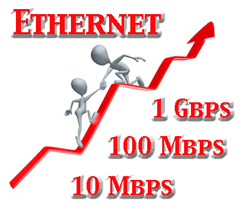You know it’s time to upgrade your WAN bandwidth. There are two major forces at work to make this a necessity. First, the load on your network connections is steadily increasing. Second, legacy copper services that have worked so well for decades are being phased out by the carriers. It’s the right time to make a move to gigabit fiber.
 What’s Driving The Need to Upgrade
What’s Driving The Need to UpgradeInformation technology is a different animal than it was in years past. If you’ve been working in technology for ages, you probably remember when computers, their peripherals, and software were all in-house. Connections to the outside were for communication between locations and to the Internet. When there weren’t that many resources to access outside, there wasn’t a need for very high bandwidth.
That’s all changed. The entire IT architecture has been turned on its head. Now, there is very little computing done in-house and a crying need for massive connectivity to the cloud where the computers, storage, and software reside. The Internet has evolved from a simple messaging system to an almost infinitely deep well of resources on all subjects. Communications via the Internet are much more demanding due to the heavy concentration of massive files and high resolution video.
Even small businesses need what used to be considered extremely high bandwidth. Medium and larger companies can’t live without the throughput of high speed fiber optic connections.
Why Copper Connections are Disappearing
Until just a few years ago, twisted pair copper cables connected to a telephone company central office were considered standard fare for both voice and data. That was before the migration away from POTS (Plain Old Telephone Service) landlines. The replacement is VoIP telephony running on the same computer network that interconnects desktop computers, network storage, printers and servers. The in-house telephone switch, called the PBX, has suffered the same fate as most in-house servers. It has moved to the cloud.
The other use for these twisted pair cables was point to point and dedicated Internet connections at 1.5 Mbps. Those T1 lines have faded in popularity as speed demands exceeded their capacity long ago. The upgrade, DS3 delivered on coaxial copper cables, travelled most of the distance multiplexed on SONET fiber optic cable. Only the connection from the curb was copper.
Faced with a waning demand for copper-based telecom services that are ordered less often by businesses and are too slow to support 4G LTE and 5G cellular stations, the telephone companies that own the copper are either ripping it up for recycling or letting it corrode in the ground. It won’t be long and you’ll have to upgrade even if you don’t need the additional bandwidth.
The New Standard is Fiber Optic Ethernet WAN
The majority of telecom traffic now is Ethernet packets. Rather that convert the protocol to and from legacy telco services, Ethernet over Fiber is the new WAN standard.
Bandwidths are typically available from 10 Mbps at the low end to 10 Gbps at the high end, with 100 Gbps available in some major areas.
Like earlier copper telecom solutions, you have the option of setting up point to point private lines or dedicated Internet access. Both are supported by Ethernet over Fiber. Private lines offer dedicated bandwidth so you don’t have to compete with other companies for the capacity of the line. Dedicated Internet Access also gives you exclusive use of last mile connectivity. Of course, the Internet itself is a shared medium.
How about availability? Fiber optic lines are becoming almost ubiquitous these days. The exception is rural areas or remote business and industrial parks that aren’t served by fiber yet. Sometimes you can get near-fiber performance by cable broadband solutions that can reach 1 Gbps of shared bandwidth at bargain prices. If you are located remotely, you can often get 4G LTE and 5G wireless business solutions that many not offer the ultimate in bandwidth, but are often great solutions to replace obsolete copper lines.
Is your business running short on bandwidth or have you been notified that your copper bandwidth options are being discontinued? If so, now is the perfect time to check out prices and availability of gigabit fiber optic bandwidth for your business locations.

